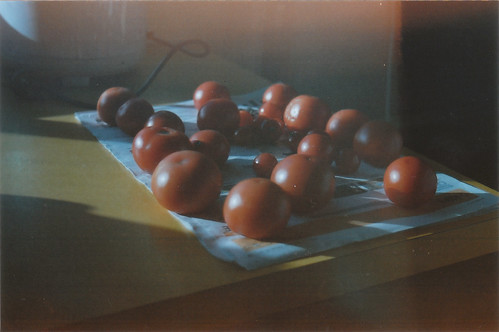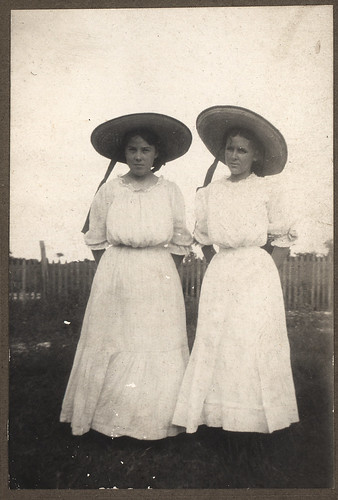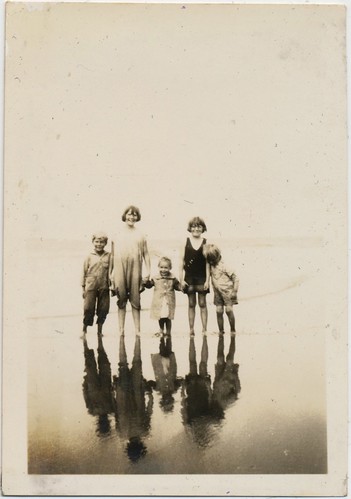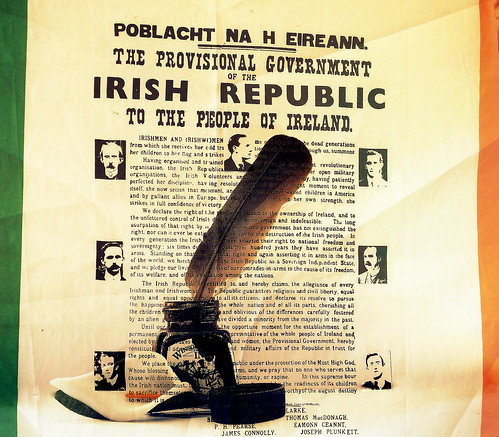We learned about the links between
Muriel and Grace Gifford and Greystones
from the book:
‘Unlikely Rebels – The Gifford Girls and the Fight for Irish Freedom’
by Anne Clare published by Mercier Press 2011
You can read about what we learned below
or download a powerpoint
about their connections with the town
where we go to school here:
Muriel& Grace Gifford; Their Connections with Greystones
What were the Gifford Sisters’ links with Greystones?

 simpleinsomnia via Compfight
simpleinsomnia via Compfight
1. As children the Gifford family used to come to Greystones
on holidays every summer.
There were twelve children in the family.
The Gifford children learned to swim in Greystones.
While their father Frederick taught the boys,
their mother Isabella employed a woman called Ellen,
who made sure the girls, would be strong swimmers.

 Simon Greening via Compfight
Simon Greening via Compfight
On page 22 we read:
‘Frederick (their father) took an interest in gardening,
bringing some plants over from England.
One particular return from their two-month annual summer stay
in Greystones, County Wicklow,
was recalled by Nellie (their sister)
because on their arrival home
not only had the grass grown almost knee-high
but the plants her father had put down before leaving
were ‘climbing and sprawling’,
and, most curious of all, low-growing, very red apples were in fruit.
On biting the apples, the children discovered
they were a new ‘fruit’ which they had never encountered before
and which they were told were called tomatoes’
 dvdflm via Compfight
dvdflm via Compfight
2. Two sisters of Muriel and Grace; Nellie and Ada
were bought hats by their mother that they did not like.
On page 26 of ‘Unlikely Rebels’ it says:
‘The reluctant boater-wearers waited for their chance,
which came with the annual holiday in Greystones,
They walked down to the breakwater,
where the sea was deep,
and whirled the hated hats into the water,
as far as they could,
gleefully watching the little boats riding the waves
till they were so sopping with water that they sank.
They decided to accuse the blameless wind as the culprit
which had ‘unfortunately’ snatched their hats from them, elastic and all.’
 (OvO) via Compfight
(OvO) via Compfight
3. Their mother was called Isabella
and the family lived in Rathmines, in Dublin.
On page 43 of the book we read:
‘Sometimes Isabella’s concern was ‘keeping up with the Joneses’.
And such, in part at least, was the annual holiday in Greystones.
This was considered so socially necessary in Rathmines
that those who could not afford to go would
pull down their blinds as camouflage
and live in the back of the house during the Summer months.’
‘Greystones was largely owned by the Huguenot La Touche family
…Then a small fishing village, Greystones was slowly developing
after the opening of the railway line from Dublin in 1850.
There emerged a sort of unwritten law in Dublin
which observed geographical distributions of holiday areas
for Protestants, Catholics and Jews.
The Protestants gravitated towards Greystones,
partly because of the influence of the La Touche family
and partly also because Wicklow (the ‘Garden’ of Ireland)
was almost exclusively in the hands of Protestant landowners.
Greystones was, as it were, one of their marine suburbs’.
On page 44 ‘There is a description in sister Nellie’s memoirs
of their setting off for the yearly Greystones summer holiday
…seventeen people…Isabella’s ‘husband, her sons and the maids
stagger down the steps with huge baskets laden with crockery,
household utensils, clothes, bedding and food.
‘The maids hated the holidays and it is easy to see
that even the going and the coming back were heavy chores;
Nevertheless, their shrewd young charges noted that when
the coastguards started to call at the kitchen
in the rented house at Greystones, the extra drudgery was forgotten
as a bit of flirtation lightened the scene.’
On page 46 it says:
‘Not the least of the Greystones delight for the children
were the establishments that hired out
horse-drawn vehicles by the hour, a half day or a full day
…The favourite conveyance for the Gifford children however,
was a pony and trap which they were allowed to drive themselves.
The ‘pony’ could be either a donkey or a jennet,
and their favourite haunt was the Glen of the Downs’.
(A jennet is a female donkey.)
‘For the Gifford children, these holidays were times of freedom
and wandering over the countryside,
finding fraocháns and wild strawberries
in the fields about the house where they were staying,
picking blackberries to make jam
which was consumed while it was still warm,
getting up at dawn in the chill air to pick mushrooms
and then running back home to put them on the hob upside down,
with a knob of butter before eating them’.
(Fraocháns are bilberries).
‘There were days in the cove with Ellen,
days taking turns at driving the trap,
and days when they stood and listened
to the strange new music coming from America via England’.
According to the book ‘Unlikely Rebels’ by Anne Clare, Mercier Press 2011
these are links between the Gifford Sisters and Greystones.
Anne Clare based her book on the Gifford sisters on family papers
and a diary kept by Grace that was given to her.
Graphics: from Compfight.
Please note: These are not photos of Greystones or the Gifford sisters.
Information in this post from
‘Unlikely Rebels – The Gifford Girls and the Fight for Irish Freedom’
by Anne Clare, Mercier Press 2011






